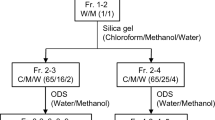Abstract
Protamine is a basic protein whose sulfate is used in medical applications as a carrier for injectable insulin and as a heparin antagonist, while its hydrochloride is used as an antibacterial ingredient for some food products. We previously showed that protamine hydrochloride derived from chum salmon milt inhibited pancreatic lipase and reduced plasma triacylglycerol levels in an oral fat tolerance test in humans. The present study evaluated the effect of chum protamine hydrochloride on lipid metabolism in rats. The single oral administration of protamine hydrochloride (500 mg/kg) reduced plasma triacylglycerol levels in a corn oil tolerance test, and repeated oral administration at a dose of 0, 150, 500, or 1,500 mg/kg with a high fat diet for 7 weeks significantly reduced body weight gain, liver weight, and epididymal adipose tissue, whereas total calorie intakes were not significantly different. These findings could be caused by the suppression of lipid digestibility leading to a significant increase in fecal lipid excretion due to the fact that protamine hydrochloride could bind with bile acids to make a complex that is difficult to digest. Protamine hydrochloride, with a considerable history as food, can be considered to be promising as an anti-obesity functional food material.

Similar content being viewed by others
References
Miescher F (1874) Das Protamin, eine neue organische Base aus den Samenfäden des Rheinlachses. Hoppe-Seyler’s Med Chem Untersuchungen Ber dtsch Chem Ges 7:376–379
Hoffmann JA, Chance RE, Johnson MG (1990) Purification and analysis of the major components of chum salmon protamine contained in insulin formulation using high-performance liquid chromatography. Protein Expr Purif 1:127–133
Hagedorn HC, Jensen BN, Krarup NB, Wodstrup I (1936) Protamine insulinate. J Am Med Assoc 106:177–180
Jorpes E, Edman P, Thaning T (1939) Neutralization of action of heparin by protamine. Lancet 2:975–976
Tsujita T, Matsuura Y, Okuda H (1996) Studies of the inhibition of pancreatic and carboxylester lipase by protamine. J Lipid Res 37:1481–1487
Hoshino Y, Takahashi Y, Kawarasaki M, Akita R, Enari H, Yamamoto S (2008) The suppressive effect of protamine from chum salmon milt on lipid absorption in humans (in Japanese with English abstract). Nippon Shokuhin Kagaku Kogaku Kaishi. J Jpn Soc Food Sci Technol 55:360–366
Duarte-Vázquez MA, García-Padilla S, Olvera-Ochoa L, González-Romero KE, Acosta-Íñiguez J, De la Cruz-Cordero R, Rosado JL (2009) Effect of protamine in obesity induced by high-fat diets in rats. Int J Obes 33:687–692
Hosomi R, Fukunaga K, Arai H, Kanda S, Nishiyama T, Yoshida M (2010) Effect of dietary protamine on lipid metabolism in rats. Nutr Res Pract 4:462–469
Strippoli V, D’Auria FD, Simonetti N (1990) In vitro antimicrobial activity of econazole and miconazole sulfosalicylate. Drugs Exp Clin Res 16:237–242
Bligh EG, Dyer WJ (1959) A rapid method of total lipid extraction and purification. Can J Biochem Physiol 37:911–917
Sugiyama K, Takada K, Egawa M, Yamamoto I, Onzuka H, Oba K (1991) Hypotensive effect of fish protein hydrolysate (in Japanese with English abstract). Nippon Nogeikagaku Kaishi 65:35–43
Enari H, Takahashi Y, Kawarasaki M, Tada M, Tatsuta K (2008) Identification of angiotensin I-converting enzyme inhibitory peptides derived from salmon muscle and their antihypertensive effect. Fish Sci 74:911–920
Fujita H, Hirokado M, Hirata K, Uematsu Y, Sadamasu Y, Yasuda K, Aoki N (1996) Mutagenicity of natural food additives in the Ames Salmonella/microsome test (in Japanese with English abstract). Tokyo Toritsu Eisei Kenkyujo Kenkyu Nenpou. Annu Rep Tokyo Metrop Res Lab Publ Health 47:309–313
Yoshida S, Aoki N (1997) Cytogenetic studies of natural food additives on Chinese hamsters (in Japanese with English abstract). Tokyo Toritsu Eisei Kenkyujo Kenkyu Nenpou. Annu Rep Tokyo Metrop Res Lab Publ Health 48:342–344
Tada Y, Ikeda T, Takahashi H, Yano N, Yuzawa K, Nagasawa A, Sakamoto Y, Fukumori N, Mikuriya H, Tayama K, Aoki N, Sasaki M (1998) Subchronic toxicity test of natural preservative, milt protein, in rats by dietary administration (in Japanese with English abstract). Tokyo Toritsu Eisei Kenkyujo Kenkyu Nenpou. Annu Rep Tokyo Metrop Res Lab Publ Health 49:267–276
Hill JO, Hauptman J, Anderson JW, Fujioka K, O’Neil PM, Smith DK, Zavoral JH, Aronne LJ (1999) Orlistat, a lipase inhibitor, for weight maintenance after conventional dieting: a 1-y study. Am J Clin Nutr 69:1108–1116
Nakai M, Fukui Y, Asami S, Toyoda-Ono Y, Iwashita T, Shibata H, Mitsunaga T, Hashimoto F, Kiso Y (2005) Inhibitory effects of oolong tea polyphenols on pancreatic lipase in vitro. J Agric Food Chem 53:4593–4598
Hara Y, Moriguchi S, Kusumoto A, Nakai M, Ono Y, Abe K, Ohta H, Shibata H, Kiso Y, Egawa K (2004) Suppressive effect of oolong tea polymerized polyphenols-enriched oolong tea on postprandial serum triglyceride elevation (in Japanese with English abstract). Yakuri to Chiryou. Jpn Pharmacol Ther 32:335–342
Wu G, Morris SM Jr (1998) Arginine metabolism: nitric oxide and beyond. Biochem J 336:1–17
Garcia-Villafranca J, Guillen A, Castro J (2003) Involvement of nitric oxide/cyclic GMP signaling pathway in the regulation of fatty acid metabolism in rat hepatocytes. Biochem Pharmacol 65:807–812
Jobgen W, Meininger CJ, Jobgen SC, Li P, Lee MJ, Smith SB, Spencer TE, Fried SK, Wu G (2009) Dietary l-arginine supplementation reduces white fat gain and enhances skeletal muscle and brown fat masses in diet-induced obese rats. J Nutr 139:230–237
Matsuzawa T, Nomura M, Unno T (1993) Clinical pathology reference ranges of laboratory animals. J Vet Med Sci 55:351–362
Van Beekel TJC, Vaandrager H, Kruijt JK, Koster JF (1980) Characteristics of acid lipase and acid cholesteryl esterase activity in parenchymal and non-parenchymal rat liver cells. Biochim Biophys Acta 617:446–457
Author information
Authors and Affiliations
Corresponding author
Rights and permissions
About this article
Cite this article
Takahashi, Y., Konishi, T., Enari, H. et al. Effects of protamine hydrochloride from chum salmon milt on lipid metabolism in rats. Fish Sci 77, 1045–1052 (2011). https://doi.org/10.1007/s12562-011-0399-7
Received:
Accepted:
Published:
Issue Date:
DOI: https://doi.org/10.1007/s12562-011-0399-7




